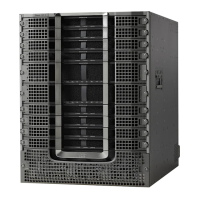The peak-rate value can also be configured through cable service class command which forms part of the
service class template. During modem registration or Dynamic Service Addition (DSA) operation, the service
class name TLV 25.4 is sent to create the static or dynamic downstream service flow that matches the service
class template. These downstream service flows are created with a specific peak-rate . If the peak-rate is not
specified, then the value specified by the cable ds-max-burst command is used.
If a service flow has both service class and TLV 25.27 defined peak-rate , then the peak-rate value specified
in the TLV is used.
Some of the DOCSIS 1.x and DOCSIS 2.0 cable modems, which are not fully DOCSIS 1.x or DOCSIS 2.0
compliant, may fail to come online when they receive TLV 25.27 from the Cisco CMTS during registration.
In order to overcome this you can configure the cable service attribute withhold-TLVs command with the
peak-rate keyword to restrict sending of this TLV to non-DOCSIS 3.0 cable modems.
DOCSIS 3.0 Downstream Bonding Support with Bonding Group Dynamic
Bandwidth Sharing
DOCSIS 3.0 introduces the concept of downstream channel bonding. Each Bonding Group (BG) is made up
of a collection of downstream channels, which can be used by one or more bonding groups. Each downstream
channel can also serve as a primary channel in a MAC domain and carry non-bonded traffic, while being part
of a BG.
Prior to DOCSIS 3.0 standards, the downstream service flows were associated with a single downstream
interface, which in turn corresponded to a physical downstream on an RF channel. In DOCSIS 3.0, the
downstream service flows are associated with the downstream bonding groups. These bonding groups can
use multiple downstream RF channels.
DBS is the dynamic allocation of bandwidth for wideband (WB) and integrated cable (IC) interfaces sharing
the same downstream channel. Due to the channel sharing nature of the bonding groups, the bandwidth
available to bonding groups or non-bonded channels is not fixed. The bandwidth depends on the configuration
and the traffic load on the WB or IC.
Bonding groups are implemented as WB interfaces and non-bonded channels as IC interfaces.Note
In the DBS mode, the bandwidth of the shared RF channels is dynamically allocated among the WB and IC
interfaces. The DBS enables efficient use of the underlying RF channel bandwidth even in the presence of
high burst traffic. The DBS is configured at the WB or IC interface level. By default, bandwidth for a WB or
IC channel is statically allocated (non-DBS).
For information about DBS support on the Cisco CMTS routers, refer to the Dynamic Bandwidth Sharing on
the Cisco CMTS Router feature.
How to Configure DOCSIS WFQ Scheduler
You cannot configure the DOCSIS WFQ Scheduler feature as it is automatically loaded. The parameters that
the schedule uses include the interface bandwidth and queue parameters.
This section describes the following required and optional procedures:
Cisco cBR Series Converged Broadband Routers Quality of Services Configuration Guide for Cisco IOS XE
Fuji 16.7.x
86
DOCSIS WFQ Scheduler on the Cisco CMTS Routers
DOCSIS 3.0 Downstream Bonding Support with Bonding Group Dynamic Bandwidth Sharing

